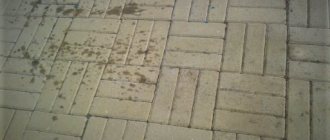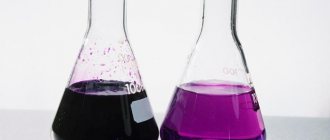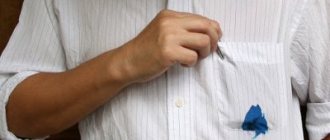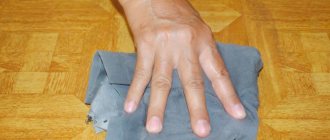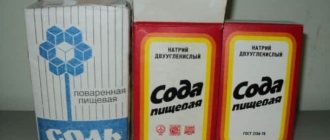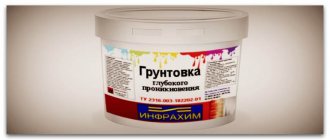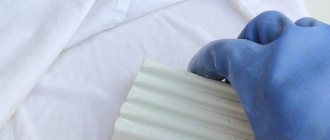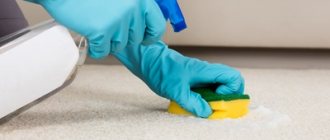There are different types of stains on clothes, some are easy to remove, while others are difficult to remove. But without removing stains and washing away various dirt, we cannot bring our clothes to an ideal, clean state. In this article we will talk about removing not the most common, unpleasant, but common stains from bird droppings; we will look at the most effective means of removing bird droppings from clothes.
A very unpleasant situation with the coat
Fresh tracks
Many of us have encountered the problem of traces of bird droppings appearing on clothes and other things. It could be an accident on the street, or perhaps... Like any other stain, it is most easily removed when fresh, and only old bird stains are difficult to remove from things.
Removing a fresh stain from bird droppings will not be difficult; we will need clean water and a soft sponge. If the stain has already begun to gradually be absorbed, then you will need to act according to the following scheme:
- Take a spoon or a dull knife and scrape any traces of droppings from the fabric, rinse the stained area with cold running water.
- Spread the clothes on a horizontal surface and place a rag under the contaminated area to absorb excess liquid.
- Apply water to the traces of droppings gradually and constantly until you notice that the contamination has completely dissolved and has completely begun to disappear.
- Now we should remove the remaining dirt with a napkin or soft sponge, and then cover the treated area with bread crumbs.
- As it dries, you will already be able to see whether any traces will remain or not. If you see that the stain has not completely come off, then additionally treat the stained area with gasoline using a cotton pad. Choose pure gasoline, which is sold in construction and hardware stores.
- Remaining traces of gasoline can be removed from fabric with a 5% vinegar solution. After which you should additionally rinse the treated area with warm water and dry.
- For white items, you can use hydrogen peroxide, or immediately take a bleach suitable for this fabric. Before using bleach, do not forget to check its capabilities on the inside of the clothing, and then proceed to the front.
This is quite normal for city residents.
If we consider household chemicals and related products, here you can find various good products, for example, wet wipes from the Amway brand. Despite the fact that such napkins are not cheap, they remove dirt very well. With their help, you can remove various fresh and old stains, including traces of bird droppings that you just brought into the house.
Usually fresh traces of bird droppings are removed quite easily, but with old ones you have to tinker. The fact is that droppings largely consist of phosphorus and nitrogen, which allow it to penetrate deeply into the structure of the tissue and attach to its fibers. That is why serious difficulties can arise when cleaning things from old stains of bird droppings.
How to remove bird droppings from clothes?
How to remove bird droppings from clothes? — This question is quite relevant, because perhaps each of us has encountered an unpleasant situation when a bird soiled our clothes. In this article we will talk about how to get rid of such stains and other stubborn stains.
Depending on how long the bird stain has been on the clothing, the methods for removing it will vary. Of course, fresh dirt is much easier to remove than dried dirt. Let's consider options for action in both cases.
Old stains
If you find unpleasant traces of birds on your favorite clothes, do not despair; there are a number of effective ways to clean things from such contaminants, and most of them are based on products that are found in every home.
Using gasoline and acetic acid can help with the most stubborn stains. The principle of using these funds is as follows:
- First of all, you need to place the item on a horizontal surface and try to partially remove the dirt using a brush.
- Then, using a cotton pad soaked in gasoline, you need to carefully treat the affected area of clothing. In this case, it is advisable to place a cotton wool or a well-absorbing rag under the stain.
- After using gasoline, rinse the cleaned area with clean water and wipe with a sponge or brush.
- To slightly dry the fabric, you can use paper napkins and bread crumbs, which will additionally draw out the remaining droppings.
- If small traces remain, they can be easily washed off the fabric with a 5% acetic acid solution.
- Clothes can now be washed normally to remove any residual cleaning products and unpleasant odors.
Dangerous city birds
Some housewives create gasoline-based soap that allows you to remove greasy stains from fabric. It’s difficult to call such a solution soap, but in our case this detergent composition will also be useful and effective.
The recipe for gasoline soap is as follows: It is necessary to mix together the following components - 150-200 ml of gasoline, 3-5 ml of ethyl alcohol, 10-15 ml of oleic acid, and then, while continuing to stir the solution, pour in 5-8 ml of 25% ammonia.
The resulting solution will allow us to get rid of annoying bird stains; we will apply it as follows:
- You should pour gasoline soap on the stains and leave to soak for 10-15 minutes.
- After a specified time, the dirt is removed with a brush, which is additionally moistened in the cleaning solution. At the end of the work, the cleaned areas are sprinkled with talcum powder.
- If after such treatment there are still faded traces, they should be additionally treated with heated glycerin. You can use the same vinegar, which does an excellent job of removing bird tracks.
- After all procedures, clothes should be washed as usual and dried, and then evaluate your work.
For deep and stubborn stains, ammonia can be added to a mixture of gasoline and vinegar. The ammonia it consists of perfectly removes such contaminants. The cleaning principle in this case is as follows: first we wipe the stains with ammonia, rinse with water, then with gasoline, rinse with water, and then, if necessary, with vinegar, and send the clothes to the wash.
It perfectly removes such contaminants from things during regular washing in tandem with Vanish and laundry soap. If you use pre-soaking, then for white things it must be done in bleach and washing powder with enzymes. After that, regular washing will be enough to completely clean the material.
Undoubtedly, the appearance of bird marks on clothes negatively affects your mood and forces you to take decisive measures, but on the other hand, according to popular superstitions, bird marks attract money. Therefore, do not be too upset, but immediately begin removing bird droppings from your clothes, because if it gets into the fabric, it will be more difficult to do this.
Which balconies do pigeons like to roost on?
Pigeons love space, wide railings, piles of boxes and furniture on open balconies, where they can build a nest. Availability of water and food on the block, as well as silence.
How to scare birds away from the balcony?
- Birds do not like noise, so if possible, place speakers with music closer to the balcony door or window.
- Cut the food foil into strips; the rustling and shine will scare away the pigeons for a while.
- Hang CDs; birds don't like their glare.
- Lubricate the ledges on which birds like to sit with Vaseline.
- Cut off the bottom of a plastic bottle, then cut a 2-3 cm fringe along the length, not reaching the neck. Place it on the floor of the balcony (like an octopus) and press on the neck. The plastic gives off glare, like water, which scares away pigeons.
- Place a stuffed raven, it will scare away for several months, but then the pigeons will get used to it and the stuffed animal can be used again next season.
- If it seems unaesthetic to you to cover the beam with netting, then this method will be completely invisible: pull the fishing line at a height of 5 cm from the railing. It is invisible, but will prevent the pigeons from landing.
- You can also scare away pigeons with the help of strong odors: place mothballs on the balcony or install an automatic air freshener with a strong smell.
- Mustard has an effective effect on birds’ sense of smell; you just need to add it periodically.
- Among electronic repellers, it is advisable to choose Ultrasonic (not sound) ones, and make sure that the frequencies used in the device are not audible to you personally.
What if a pigeon's nest with eggs appeared on the balcony?
There is no use throwing it away, the pigeons will build a new one. It is better to place a dummy, such as chalk, instead of eggs. After some time, the birds will realize that the chicks have not hatched and will leave this place forever. Pigeons do not return to places unfavorable for breeding.
Ecology of life. Health: Today I once again watched children cuddle pigeons and crawl around in their droppings, joyful and dangerously carefree. So I decided to warn...
People perceive pigeons in different ways: some - for (a symbol of peace, love, without human support they will die); others are against it (“flying rats”, annoying, unclean, carriers of infection).
Today I once again watched how children cuddle pigeons and crawl in their droppings, joyful and dangerously careless. Therefore, I decided to warn you that city pigeons can pose a serious threat to your health, as they are carriers of many infectious diseases. Even worse, pigeon feces are a source of infection and inhaling them is no less dangerous than direct contact with pigeons.
And one pigeon is 12 kilograms of feces per year! This seemingly harmless bird can be a carrier of 90 pathogens of many diseases, including ten zoonotic infections (zoonoses), that is, those that are transmitted to humans from animals.
Diseases transmitted from animals to humans are called zoonoses.
The causative agents of these diseases can be protozoa, fungi, bacteria, chlamydia and viruses. Each person’s individual susceptibility to them depends on the state of the immune system, age, health status and other factors.
How to remove bird droppings from clothes if the contamination is fresh?
It is not so difficult to get rid of fresh pollution. A sponge soaked in water will be enough.
Procedure to remove bird droppings from clothes:
- Place an absorbent pad under the stain.
Important! The absorbent backing should be changed frequently during cleaning.
- Wet the problem area until the stain comes off.
- Then the treatment area should be wiped with a napkin and sprinkled with bread crumbs.
- When the treated area is already dry, it should be rubbed with a swab dipped in gasoline.
- If traces still remain after treatment, you need to wipe them with a five percent solution of acetic acid.
- After this procedure, rinse the stained area with warm water and dry it.
- If the stain remains, you can try removing it with 3% hydrogen peroxide or another fabric-safe bleach.
Important! First, test the effect of the bleach on the wrong side of the fabric.
Psittacosis
Ornithosis (also known as psittacosis or parrot disease) is a bacterial infection that most often affects parrots and their relatives, however, it sometimes appears in other birds, including pigeons. A person can become infected with psittacosis if they accidentally inhale particles of dried droppings from a sick bird.
10 days after infection, a sick person develops weakness, fever, headache, rash, chills and pneumonia.
Chlamydia psittaci was found in 52.6 percent of captured pigeons. Infection from this bacterium leads to symptoms such as mild flu-like illness and severe pneumonia. Most often, such diseases are recorded in spring and autumn, this is due to decreased immunity in young birds and their susceptibility to diseases.
Of greatest epidemic importance are farm birds (ducks, turkeys), indoor birds (parrots, budgies, canaries and other small songbirds) and especially city pigeons, the infection rate of which ranges from 30% to 80%.
The causative agent of ornithosis, unlike other chlamydia, is capable of long-term preservation in the environment: it remains viable at a temperature of 37 ° C for up to 2 days, at 4–6 ° C for a week; After lyophilization, the pathogen persists for 5 years or more.
The incubation period for psittacosis ranges from 5 to 30 days (usually 10–12 days). At the onset of the disease, fever with chills and increased sweating, pain in the throat, muscles and joints are characteristic. Conjunctivitis, a thickened tongue with possible tooth marks along the edges, often hepatolienal syndrome, and emotional disturbances (excitement, irritability, tearfulness) are noted. From the 3rd–4th day of illness, laryngitis or bronchitis, interstitial or small focal pneumonia develop with scant physical data.
During a special examination for ornithosis in different countries (Bulgaria, Holland, USA, Germany, etc.), it was found that 10–20% of acute pneumonia has an ornithosis etiology. In Moscow, ornithosis was detected in 18.4% of patients with acute pneumonia, in St. Petersburg - in 19.6%.
Doctors note that although there are no seasonal outbreaks of psittacosis, people still get sick more often in the cold season. This is caused by a number of reasons, one of which is the similarity of the symptoms of psittacosis with the symptoms of ARVI and common colds, which makes diagnosis difficult. In addition, in cold weather, pigeons gather in large flocks and, therefore, the infection spreads faster. One sick bird can infect the entire flock. And then this sick flock scatters into city garbage containers, which are often installed near places where children walk.
Thus, there are many places around the city where you can catch psittacosis and other diseases. Ornithologist Natalya Obukhova says in this regard that garbage and dirt in cities contributes to a rapid increase in the number of pigeons. Nobody monitors the bird population in Moscow, but the incidence of psittacosis among Muscovites is an order of magnitude greater than that of rabies.
People are more resistant to psittacosis, but the course of the disease is severe (severe headaches, fever, weakness of the whole body). It is very similar to influenza and acute respiratory diseases. Children catch the infection much more often than adults, as they can touch birds while playing with them. Children need to be supervised and explained to them what troubles can arise from interacting with birds.
Salmonellosis
Salmonellosis is an intestinal disease caused by numerous pathogens of the Salmonella genus. The main sources of infection are animals, and occasionally people. The asymptomatic course of the disease has been established in many species of farm animals, cats, dogs, rodents, and birds.
“The disease does not pose a danger to humans, provided that standard personal hygiene measures are observed and direct contact with sick birds is avoided. The causative agents of avian influenza and psittacosis (an infection that can be transmitted to humans) have not been identified,” the committee said.
Common clinical signs in all animals include diarrhea, vomiting, and fever. The infection can progress towards dehydration, weakness, and sometimes, especially in the case of very young or very old individuals, death. Severe cases may include high fever, septicemia (blood poisoning), headaches, and an enlarged, painful spleen. Focal infections can occur in a variety of organs, including the heart, kidneys, ligaments, soft membranes surrounding the brain and spinal cord, and connective tissues surrounding all the bones of the body.
The incubation period is 12−36 hours. Salmonella is spread by eating food contaminated with droppings. The shedding of bacteria by a sick person can last from several days to several weeks.
Campylobacter jejuni
Until 1972, when a reliable method for their isolation was developed, Campylobacter jejuni was considered pathogenic only for animals (sheep and cattle). However, further research has shown their danger to humans. According to the US Food & Drug Administration, Campylobacter jejuni is currently the most common cause of bacterial diarrhea in humans. Moreover, C.jejuni causes more cases of disease than Shigella spp. and Salmonella spp. taken together.
They are present in most representatives of this bird population and turn out to be more harmful than the well-known Salmonella. Outdoor pigeons serve as reservoirs for the production and growth of bacterial species, hence they can lead to harmful diseases.
Campylobacter jejuni, which was present in 69.1 percent of captured pigeons, causes abdominal pain, diarrhea, fever and general malaise in infected individuals. Thermophilic Campylobacter species are considered the main causative agents of acute diarrheal diseases around the world, more often than Salmonella.”
Newcastle infection
A sick pigeon can also infect a person with Newcastle infection through the mucous membrane of the eye. True, for humans it is not as dangerous as for birds; it occurs in the form of a cold, conjunctivitis with swelling of the parotid lymph nodes within one week. Poultry farm workers and laboratory workers may be mainly affected.
Paramyxovirus
So, pigeons are a natural carrier of paramyxoviruses, which can spread to poultry: chickens, turkeys, geese, ducks, pheasants, guinea fowl and even ostriches, emus and rheas. The virus is stable and is shed in pigeon droppings, in which it can survive for about 3–4 weeks. This means that your soles and even clothes can be a vehicle for viruses.
Because paramyxovirus, although not fatal to humans, is still capable of causing very unpleasant diseases in people. As Alexey Alekseenko, assistant to the head of Rosselkhoznadzor, noted, this infection can enter the human body through the mucous membrane of the eye, which will cause symptoms reminiscent of a cold and conjunctivitis with swelling of the parotid lymph nodes within one week. It seems nothing special, but not pleasant enough.
Superficial acariases
In addition to the scabies mite, skin lesions in humans can be caused by mites that live on animals and birds (dogs, cats, rats, pigeons), on cereals, in grass and straw, pillow feathers, etc. Most often, people are affected by the scabies mite of horses, rat, chicken and pigeon mites. The last three types can cause mass lesions in families and hostels. Unlike scabies caused by Sarcoptes hominis, these types of mites do not burrow into the stratum corneum and do not form burrows, but only inflict bites that cause severe itching and the formation of papules or blisters in their place, in the center of which pinpoint hemorrhage or more intense coloring is often visible , serous or hemorrhagic crust, vesicle (bite mark). Elements of a skin rash are most often found in places where the skin comes into close contact with the underwear. Ticks are found in underwear and bedding, and indoors.
Avian tuberculosis, which can also affect humans, is caused by Mycobacterium avium, which is similar to the classic human Mycobacterium tuberculosis. Infection occurs through water and food contaminated with bird down.
Mycobacterium affects the human respiratory and lymphatic system, causing local infectious wounds. In people with immunodeficiency, the process is generalized and can be fatal. Mycobacterium avium is often resistant to antibacterial and antituberculosis drugs, which causes difficulties in selecting therapy.
Histoplasmosis
Histoplasmosis is a disease caused by fungi growing in pigeon droppings or soil and is not spread from person to person. If a person cleaning surfaces from pigeon droppings accidentally inhales enough fungi, they will develop histoplasmosis. If you only clean the windowsill from pigeon droppings from time to time, then you have nothing to fear. 10 days after contact with fungi, weakness, fever and chest pain may appear, but for most the disease begins asymptomatically. The highest risk is in people with weak immune systems: those infected with HIV or suffering from cancer.
Cryptosporodiasis
A disease caused by protozoa (genus Cryptosporidium). In birds, the pathogen affects the pulmonary system, and in humans, the gastrointestinal system. Infection occurs through the fecal-oral route - through the consumption of foods contaminated with oocysts. The disease is manifested by nausea, vomiting, diarrhea (watery stools up to 15 times a day), abdominal pain, and weakness. Recovery usually occurs within 10 days.
Cryptococcosis
Cryptococcosis, like histoplasmosis, is caused by fungi growing in bird droppings or soil. Completely healthy people rarely get sick with cryptococcosis, even if they inhale a large number of mushrooms. This infection almost always affects people with defective immune systems; 85% of people with cryptococcosis are HIV-infected patients.
In a normal situation, for example, when you just need to wipe off dirt from a window sill, it is almost impossible to get infected. Simple protective measures are enough: wear rubber gloves and work clothes. If you are cleaning more contaminated surfaces, such as attics, roofs or any other pigeon habitat where a lot of bird droppings have accumulated, then suitable work clothing, rubber boots, gloves and respirators should be worn, especially for people with weakened immune systems. Wash your hands thoroughly before eating and after finishing work.
Allergic alveolitis
Allergic alveolitis is one of the main zoonotic diseases of birds. The disease can occur in acute, subacute and chronic forms. Clinical signs of the disease include hypersensitivity to feathers, dander, or droppings caused by decreased lung capacity. Inflammation of the alveoli, the pulmonary structures responsible for air exchange, occurs.
The acute form of the disease is usually initiated by excessive contact of a sensitive person with certain circumstances, for example, cleaning a dovecote or attic. Symptoms occur almost immediately and include cough, difficulty breathing, fever and chills. If at this stage a person stops contact with the bird, then the symptoms go away and the person does not need special treatment.
These insects can enter the apartments of our residents. In addition, pigeon droppings contain a lot of uric acid. This is also a very harmful substance. The fact is that birds do not secrete urea, but uric acid, which, when evaporated, primarily has a negative effect on the upper respiratory tract. It irritates them, and in asthmatics it can even cause attacks.
4. Don't feed pigeons from balconies.
5. Inspect the attics,
sanitizing them from pigeons.
6. Remove pigeon droppings using a respirator and special clothing!
Beware of pigeon droppings (and the ground that may be contaminated by them) as much as the birds themselves.
7. Stay away from sick pigeons.
If you notice liquid droppings or at least one of the birds with the following symptoms: disheveled, lethargic, with crooked fingers or paws, with faded or sticky plumage, as if wet, with split feathers, as if they were trimmed with small scissors, then leave immediately ! Don't tempt fate.
8. Don't pick up sick pigeons.
They are usually much less mobile than healthy ones, live alone, without a flock (which expels them due to the danger of infection), and look very pitiful. Often, precisely for this reason, they fall into the hands of children and old women with a kind heart.
9. Of course, you will enrich your shoes and clothes with viruses if you climb into the attic,
where city pigeons live, you will move boxes and other things there. Water from puddles, asphalt on the road, contaminated by birds - all this is a source of the virus.
British government services recommend that if you find a dead pigeon, do not pick it up with your bare hands - it is advisable to double-bag it and throw it in the trash or bury it (without the bag) in the ground. If you leave this work to your janitor, advise him to wear disposable gloves, which you don’t mind throwing away later. Otherwise, the janitor himself will become a carrier of infection. published
Pigeons are common city dwellers. They nest under the roofs of buildings and reproduce quickly. Chicks appear in March-July. Where pigeons live and feed, a lot of bird droppings accumulate, which can be a source of disease. Pigeons are the source of three human diseases: histoplasmosis, cryptococcosis and psittacosis.
Histoplasmosis
- a danger from pigeon droppings
Histoplasmosis is a disease caused by fungi growing on pigeon droppings or soil that is not transmitted from person to person. If a person cleaning surfaces from pigeon droppings accidentally inhales enough fungi, they will develop histoplasmosis. If you only clean the windowsill from pigeon droppings from time to time, then you have nothing to fear.
10 days after contact with fungi, weakness, fever and chest pain may appear, but for most the disease begins asymptomatically. The highest risk is in people with weak immune systems: those infected with HIV or suffering from cancer.
Cryptococcosis
- a danger from pigeon droppings
Cryptococcosis, like histoplasmosis, is caused by fungi growing in bird droppings or soil. Completely healthy people rarely get sick with cryptococcosis, even if they inhale a large number of mushrooms. This infection almost always affects people with defective immune systems; 85% of people with cryptococcosis are HIV-infected patients.
Ornithosis - the danger of pigeon droppings
Ornithosis (also known as psittacosis or parrot disease) is a bacterial infection that most often affects parrots and their relatives, however, it sometimes appears in other birds, including pigeons. A person can become infected with psittacosis if they accidentally inhale particles of dried droppings from a sick bird.
10 days after infection, a sick person develops weakness, fever, headache, rash, chills and pneumonia. Psittacosis is treated with conventional antibiotics.
The vast majority of those infected say that they played with sick poultry before becoming ill, so those at risk include those who keep poultry, pet store employees, veterinarians and people with weak immune systems. Psittacosis is not transmitted from person to person.
How to properly remove bird droppings?
In a normal situation, for example, when you just need to wipe off dirt from a window sill, it is almost impossible to get infected. Simple protective measures are enough: wear rubber gloves and work clothes.
If you are cleaning more contaminated surfaces, such as attics, roofs or any other pigeon habitat where a lot of bird droppings have accumulated, then suitable work clothing, rubber boots, gloves and respirators should be worn, especially for people with weakened immune systems. Wash your hands thoroughly before eating and after finishing work.
If you want to remove dirt by spraying it with water from a hose under pressure, then protect the area with a thick film so that splashes of dirt particles do not fly away in different directions. It is convenient to pour water on the dirt before cleaning - this will prevent infected dust from rising into the air, and you will reduce the risk of inhaling fungi and bacteria.
Instead of using pressurized water, you can choose a safer cleaning method: pour water over the clumps of droppings, wait until they are wet, and then shovel them into heavy-duty plastic bags. Litter in closed bags can be disposed of as regular garbage. And to avoid putting yourself in danger in the future, clean this area more often to prevent droppings from accumulating.
People with weakened immune systems (for example, people with AIDS or cancer) should not take part in cleaning up bird droppings, as they have a very high risk of infection.
Pigeons living on the balcony can complicate the lives of many homeowners, and also become potential carriers of dangerous diseases. The unwanted presence of a large number of these “peaceful” birds requires regular cleaning of balconies and window sills, which costs time and effort. The WINDOWS MEDIA portal will tell you how effectively.
City pigeons live in flocks and are not afraid of people, accustomed to noise, have easy access to food and reproduce quickly. They most intensively pollute places where they can rely on people for food. Scientists' studies show that pigeons are carriers of many more bacteria and diseases, even than rats - hence the common colloquial name "city rats".
How to get rid of the “crow mark” on clothes without washing?
You can remove the “crow mark” from clothes without washing. If the item cannot be washed, you should use the following recommendations.
- Moisten the area of fabric around the stain with water to prevent a halo from appearing.
- Place cotton wool under the stain and begin removing the stain using one of the methods described above.
Important! If possible, crow feces should be removed from things immediately, while they are still fresh and have not yet dried. After all, bird droppings are a caustic substance that can damage the structure of the tissue. Therefore, in order to keep your favorite item in perfect condition, you should hurry up and take measures to save it.
It is better to approach any problems with humor. If you are marked by a bird, smile, remembering the folk sign - “to the money”! Perhaps it will be true for you.
What is the problem with pigeons living on the balcony?
Pigeons are carriers of microbes that cause serious diseases of the gastrointestinal tract. Spanish researchers found the bacterium Chlamydia psittaci, which causes avian disease, in most urban pigeons. According to some scientists, this disease is considered more dangerous than salmonellosis. Brief contact with pigeon droppings on a balcony or windowsill is enough to become infected. Common symptoms include high fever, chills and muscle aches, and in some cases even severe pneumonia.
Pigeon droppings contain a huge number of larvae of fleas, flies, worms and other beetles. Therefore, it is not recommended to ignore even dry secretions, since the presence of microbes in them can lead to a number of diseases, including meningitis, respiratory diseases and toxoplasmosis.
Breathing balcony air contaminated with pigeon droppings can cause you to contract a European yeast infection (cryptococcosis). The most common symptoms of this disease are headache, blurred vision and mental distress.
Birds and their nests on balconies are also a source of allergens. Animals provide an environment (nests, feces) conducive to the proliferation of pathogenic microorganisms (for example, Histoplasma).
How to remove bird droppings from clothes if the contamination is fresh?
It is not so difficult to get rid of fresh pollution. A sponge soaked in water will be enough.
Procedure to remove bird droppings from clothes:
- Place an absorbent pad under the stain.
Important! The absorbent backing should be changed frequently during cleaning.
- Wet the problem area until the stain comes off.
- Then the treatment area should be wiped with a napkin and sprinkled with bread crumbs.
- When the treated area is already dry, it should be rubbed with a swab dipped in gasoline.
- If traces still remain after treatment, you need to wipe them with a five percent solution of acetic acid.
- After this procedure, rinse the stained area with warm water and dry it.
- If the stain remains, you can try removing it with 3% hydrogen peroxide or another fabric-safe bleach.
Important! First, test the effect of the bleach on the wrong side of the fabric.
If this situation happens to you very often because annoying birds have taken a fancy to your balcony where you dry things after washing, it’s time to solve the problem radically. Read a selection of the most effective methods on how to repel pigeons from your balcony.
Reckless feeding of pigeons by good people is the root of evil
The main reason for the constant presence of pigeons on the balcony or windowsill is the reckless feeding of these animals by people. The problem of bird droppings, especially pigeon droppings, is a real problem, which is often the result of chaotic feeding of birds on the same balcony.
The consequence of feeding birds is their habit of obtaining light food and continuous residence in the same area. Birds can wait patiently until someone re-feeds them, and not necessarily with food that is healthy for them. This harms the pigeons, who eat excessively and lose their survival instinct. One city pigeon eats 35 grams of seeds per day, 20 pigeons eat as much as one person during the day, and 80 pigeons eat 1 ton of grain per year.
Pigeons gladly accept people's good intentions and do not refuse additional feeding, generously scattered on the balcony or windowsill. It is not surprising that they do not feel the need to change their place of residence, since they prefer to be in close proximity to the so-called “light food”.
The ease of obtaining food, guaranteed by kind people, causes pigeons to lose their natural survival instincts, which can take revenge on them in the winter. Keep in mind that pigeons are capable of taking care of themselves - one bird is able to fly even 8 km in search of food. Meanwhile, fed pigeons quickly gain weight and often have problems taking off, as a result of which the bird can die, for example, by hitting the windshield of a car.
Throwing anything and everything that gets through the windows onto the windowsills creates the possibility of birds congregating in places that may later become contaminated. Thus, the result of dirty balconies and window sills is mainly the fault of man.
How to remove bird droppings from clothes?
How to remove bird droppings from clothes? — This question is quite relevant, because perhaps each of us has encountered an unpleasant situation when a bird soiled our clothes. In this article we will talk about how to get rid of such stains and other stubborn stains.
Depending on how long the bird stain has been on the clothing, the methods for removing it will vary. Of course, fresh dirt is much easier to remove than dried dirt. Let's consider options for action in both cases.
Costly cleaning up after pigeons falls on people's pockets
Large-scale pollution of the urban environment by pigeons is a serious problem. In resting places, for example, on a balcony or windowsill, birds produce large amounts of droppings, and feeding people prevents their desire to change their place of residence. As a result, urban pollution is sometimes simply catastrophic.
Pigeon droppings are a problem for property management companies because they make objects unsightly and, being a source of unpleasant odor, reduce the comfort of the residents of the house. In addition, regularly contacting a cleaning service company means high costs. Thorough cleaning of the facade is associated with high costs. For example, a one-time cleaning of an object by European standards will cost about 360 euros, and should be done approximately once a quarter.
Naturally, management companies that are faced with the negative consequences of the presence of pigeons near the property entrusted to them try to find an effective way to scare away birds, one of which is anti-bird spikes. The presence of anti-landing modules on balconies leads to the fact that pigeons decide to change their place of residence without being injured.
According to experts, birds should be fed during the winter; this period can be extended between the end of November until the first signs of spring (disappearance of snow cover). As a rule, birds should eat natural food, which is sufficient during the rest of the year in Russia. For this purpose, feeders or places designated by the property management organization should be made.
How to get rid of the “crow mark” on clothes without washing?
You can remove the “crow mark” from clothes without washing. If the item cannot be washed, you should use the following recommendations.
- Moisten the area of fabric around the stain with water to prevent a halo from appearing.
- Place cotton wool under the stain and begin removing the stain using one of the methods described above.
Important! If possible, crow feces should be removed from things immediately, while they are still fresh and have not yet dried. After all, bird droppings are a caustic substance that can damage the structure of the tissue. Therefore, in order to keep your favorite item in perfect condition, you should hurry up and take measures to save it.
It is better to approach any problems with humor. If you are marked by a bird, smile, remembering the folk sign - “to the money”! Perhaps it will be true for you.
Washing bird droppings from clothes can sometimes be as difficult as removing greasy, berry or grass stains. Therefore, you should not ignore these contaminants, but begin to eliminate them immediately.
Add a comment Cancel reply
You must be logged in to post a comment.
Not just the body!
If by some chance the birds spared the body of the car, but at the same time stained the windshield, you should also attend to the issue of cleaning as quickly as possible.
The droppings are equally aggressive towards glass surfaces; it must be removed from the glass as quickly as from the body. If, after bird droppings are removed from the car body, small scratches remain on the surface, it is worth abrasively polishing the surface. The main thing to remember when you receive a “bird’s greeting” on the hood is that you should not delay cleaning. The later you get down to business, the more difficult the process will be!
Video about bird droppings on a car's paintwork:
No car is immune from contamination by bird excretions. The faster you act, the less damage the droppings will cause to the paintwork (paintwork). We'll give you some helpful tips on how to clean up bird poop without damaging your car's paint.
So, let's look at 10 methods for removing bird droppings from a car body, as well as some tips on how to prevent it.
Bird droppings can be very harmful to car paint because they contain uric acid, which quickly damages the first layer of paint, and if the contamination is not removed, the acid can reach the paint, leaving marks that are difficult to remove.
Bird droppings also contain particulate matter that, when dry, can scratch the paint if you attempt to clean the surface without due care.
Is there protection
Unfortunately, there are currently no acid-resistant protective coatings for car bodies.
However, you can use wax and protective polymer compounds, which can protect against aggressive acidic compounds for some time. It will not be possible to forget about the problem one hundred percent, but still, the use of these products forms a moisture-repellent film on the surface of the machine body, which prevents the adhesion of contaminants of any nature. Thus, the motorist gets some time to get rid of pollution without harming the coating.
It is also important to remember that the applied protective wax or polymer layer wears off quite quickly and must be renewed regularly.
In order to reduce the likelihood of contamination, you should not park your car under trees, especially where there are bird nests, and under wires - a favorite “perch” for pigeons and other urban feathered inhabitants.
If circumstances often force you to park under trees, it is better to think about purchasing a car cover. This may seem too expensive and impractical, but believe me, dried droppings can cause a car owner much more problems than the cost of purchasing a cover and the need to cover the car with it.
Repellent
Sometimes the owners themselves are to blame for the appearance of such a problem, starting to feed the pigeons, leaving food not only in the feeder, but also on the balcony itself. Of course, it’s a noble act, but it’s better to do it outside the home.
The main thing in fighting pigeons is to be patient. We need to try to scare them away. They do this as follows:
- Use foil. Cut it into strips and hang it on the balcony. The rustling and glare will scare away annoying birds.
- Instead of foil, use CDs, they will also create glare and also add some creativity to the balcony.
- You can scare them away with the help of sound effects, by purchasing special devices that produce unpleasant sounds that are caught by the birds, or simply by playing loud music in the apartment.
- Place a stuffed crow on your balcony. As you know, this bird is the sworn enemy of the pigeon.
The above methods, although effective, may have a temporary effect.
Cleaning a wooden balcony
This technique will help you remove pigeon droppings from your wooden balcony as well as the odor from the wood. We take:
- scraper;
- broom and dustpan;
- baking soda;
- white vinegar;
- spray;
- sparkling water.
Follow these steps:
- Remove dry pigeon droppings with a scraper.
- Clean the entire area and dispose of droppings in the trash.
- Mix vinegar and water in a 50/50 ratio. Pour into a spray bottle.
- Spray water and vinegar over the contaminated surface and leave for 30 minutes.
- Wash everything with water and soda.
- Apply baking soda to the painted areas, scrub everything with a scrubbing brush. This will help remove loose droppings and stains.
- Sprinkle baking soda over everything and leave for 30 minutes.
- Wash all surfaces and leave to air dry.
Store-bought cleaning products
Have you used natural cleaning products like baking soda and detergent, but your balcony is still not as clean as you would like? You can replace them with store bought ones. They are also great for cleaning large and very dirty areas. You can buy:
- a spray cleaner that allows you to remove bird droppings without releasing particles into the air;
- floor cleaning liquid;
- dry disinfectant powders (make sure in advance that they are safe for the material from which the contaminated surface is made).
